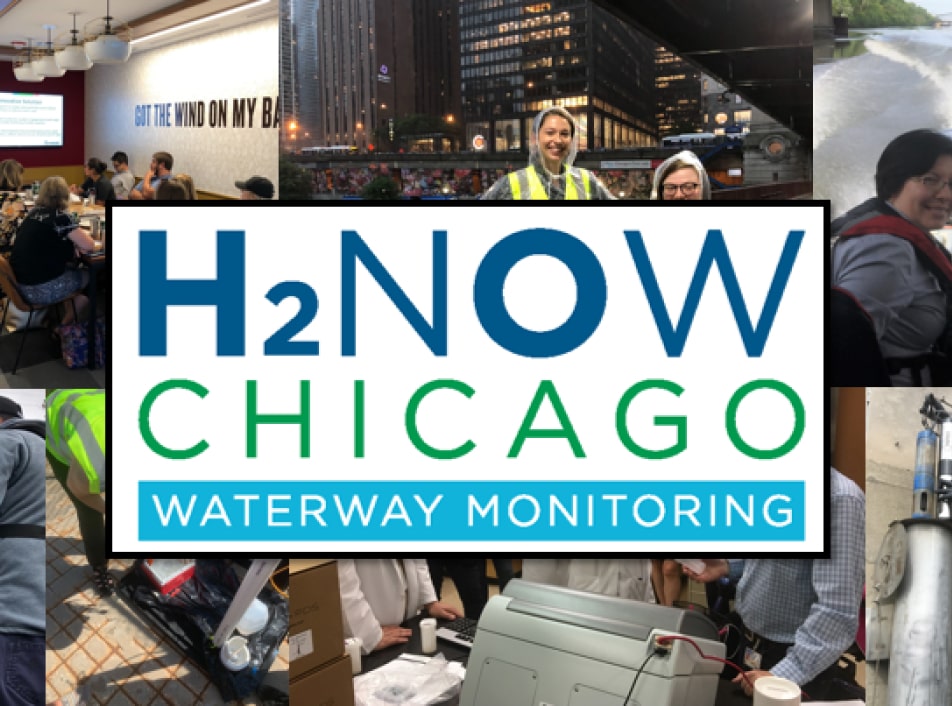Welcome to the future. A place where microbial pollutants like fecal coliforms or E. coli, micro-organisms that can indicate the presence of harmful pollutants, can now be monitored in real time and the results transparently shared with the public. Introducing H2NOW Chicago, a Current-led initiative and first-of-its-kind pilot project in the U.S. that is breaking new ground by monitoring Chicago River microbial pollution levels in real time.
Leading a carefully curated team of public and private partners that literally spans the globe, H2NOW further defines both Chicago and Current as leaders in bringing innovative solutions to critical water challenges. “Water quality is a common concern locally and globally, and the innovations needed to ensure it come from all over the world,” says Steve Frenkel, Current’s Executive Director. “By integrating exciting new technologies from Canada, Israel and the United Kingdom, Current is demonstrating its worldwide reach in sourcing and validating innovative water solutions.”
Typically, measuring microbial pollutants in waterways requires sending samples to a lab and waiting at least a day to get the results. “The challenge with existing monitoring methods is that traditional lab tests are slow,” Svetlana Taylor, Senior Analyst for Current, explains. “None come close to real time.” H2NOW is eliminating that lag altogether.
“H2NOW represents a major step towards enabling governments, businesses and the general public to gain a real-time understanding of microbial pollution in their local waterways,” Frenkel says. “By deploying novel sensors, combined with advanced data analytics, we believe that H2NOW will not only provide actionable real-time water quality measurements, but also reveal new insights into the myriad factors that influence water quality in urban rivers.”
The pilot program is designed to specifically measure fecal coliforms, bacteria that originate from warm-blooded animal feces and can spread in waterways from large events, like sewage overflows, or less conspicuous point sources, such as surface runoff that picks up animal feces left on the ground. Even though most fecal coliform bacteria are not harmful to humans, their presence indicates the potential existence of other disease-causing bacteria and viruses that can pose a health risk for individuals exposed to contaminated water. In fact, the EPA uses fecal coliforms as a key indicator in measuring recreational water quality.
After extensive research and vetting of innovative solutions, both nationally and internationally, Current identified a device built by U.K.-based Proteus Instruments as the real time technology of choice for H2NOW. The Proteus probe is a state-of-the-art sensing device that incorporates multiple sensors to detect and estimate concentrations of fecal coliforms and other water quality parameters.
“The technology uses tryptophan-like fluorescence, turbidity, and temperature measurements to calculate fecal coliform concentrations by feeding them into Proteus’ proprietary algorithm and is able to provide estimates as often as every minute,” Taylor explains. “This made it the best solution for the challenge.”
In late June, the third and final Proteus probe was installed on the Chicago River’s main stem. With all sensors successfully in place, H2NOW is entering a calibration phase that will continue through September.
Key to the calibration process is a compact and portable water testing device built by Canada-based TECTA-PDS. This innovative, EPA-certified device provides rapid water sample testing that Current is using to calibrate the Proteus probes and then validate the results they’ll provide throughout the project. Data will then be assessed to determine its reliability and fed into Israel-based IOSight’s data management platform. The company will train its artificial intelligence and predictive analytics algorithms to explore the various factors that influence water quality and derive insights based on both historical and real time water quality data.
If all goes well and Phase 1 is considered a success, the program will move on to
Phase 2 – publicly sharing the data and determining how it can be used to ensure the river continues to be an ecological, recreational and commercial asset for all Chicagoans.
H2NOW has the potential to improve public health and safety by enabling residents and visitors to check water quality in real time before they interact with the waterway. Given that water quality has been improving in recent years,Current suspects that the public will find that the river is an increasingly appealing place for recreation, tourism and commerce. This, in turn, can create a positive economic ripple effect by boosting engagement with water-based activities and corresponding business development.
In addition to improving the local health and economy, H2NOW has the potential to lead to improved environmental stewardship of the waterway. The project will provide policymakers, water utilities, property developers and industries that use the river with new insights into microbial pollution patterns and how they vary over time and location in the waterway. With this knowledge, Chicagoans will have a better understanding of the river and how to protect it.
“Providing new insights into urban waterways through H2NOW is a great example of how Current combines advanced research, technology validation and collaboration to tackle major water quality issues facing communities today,” said Frenkel.




